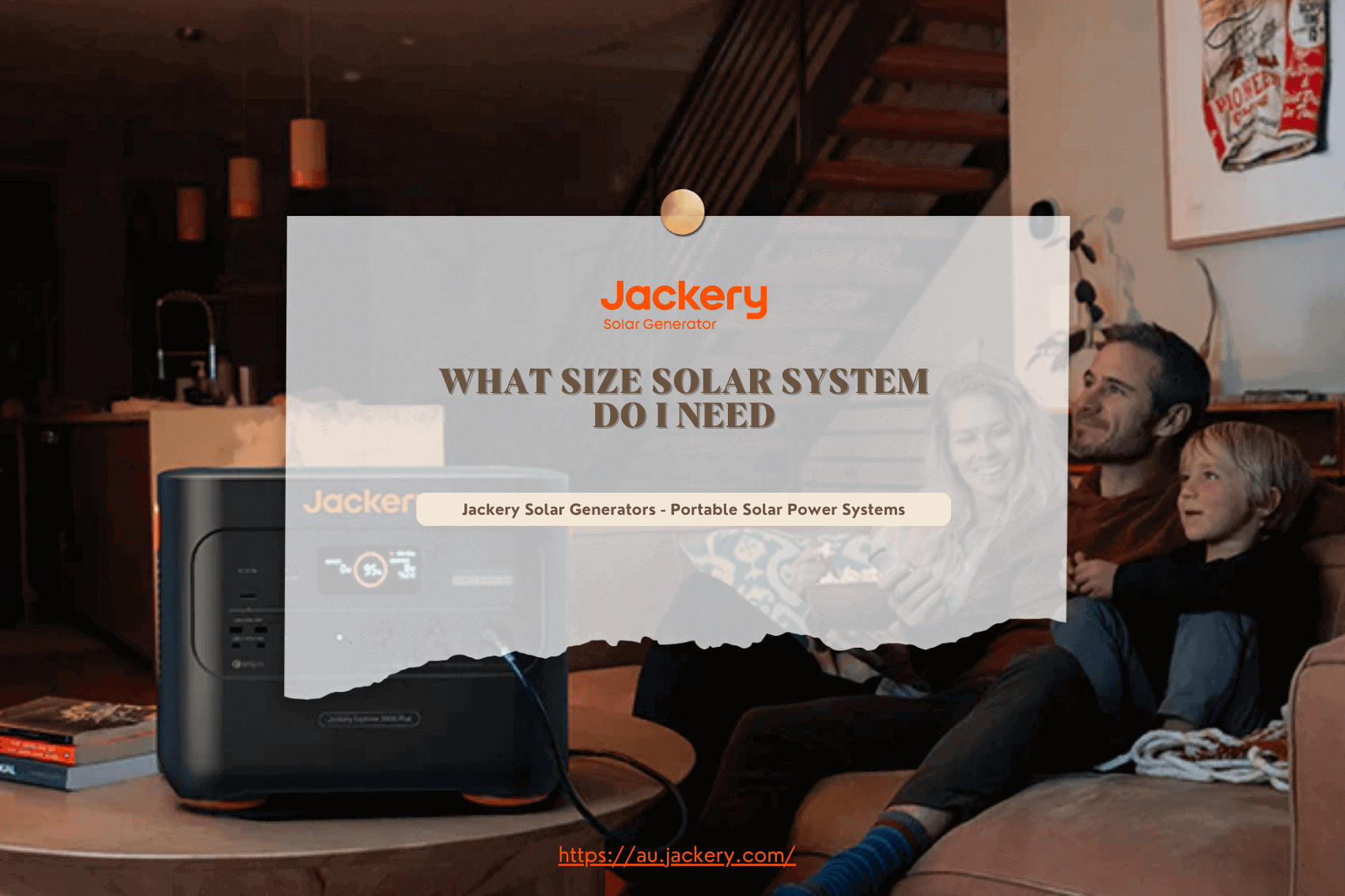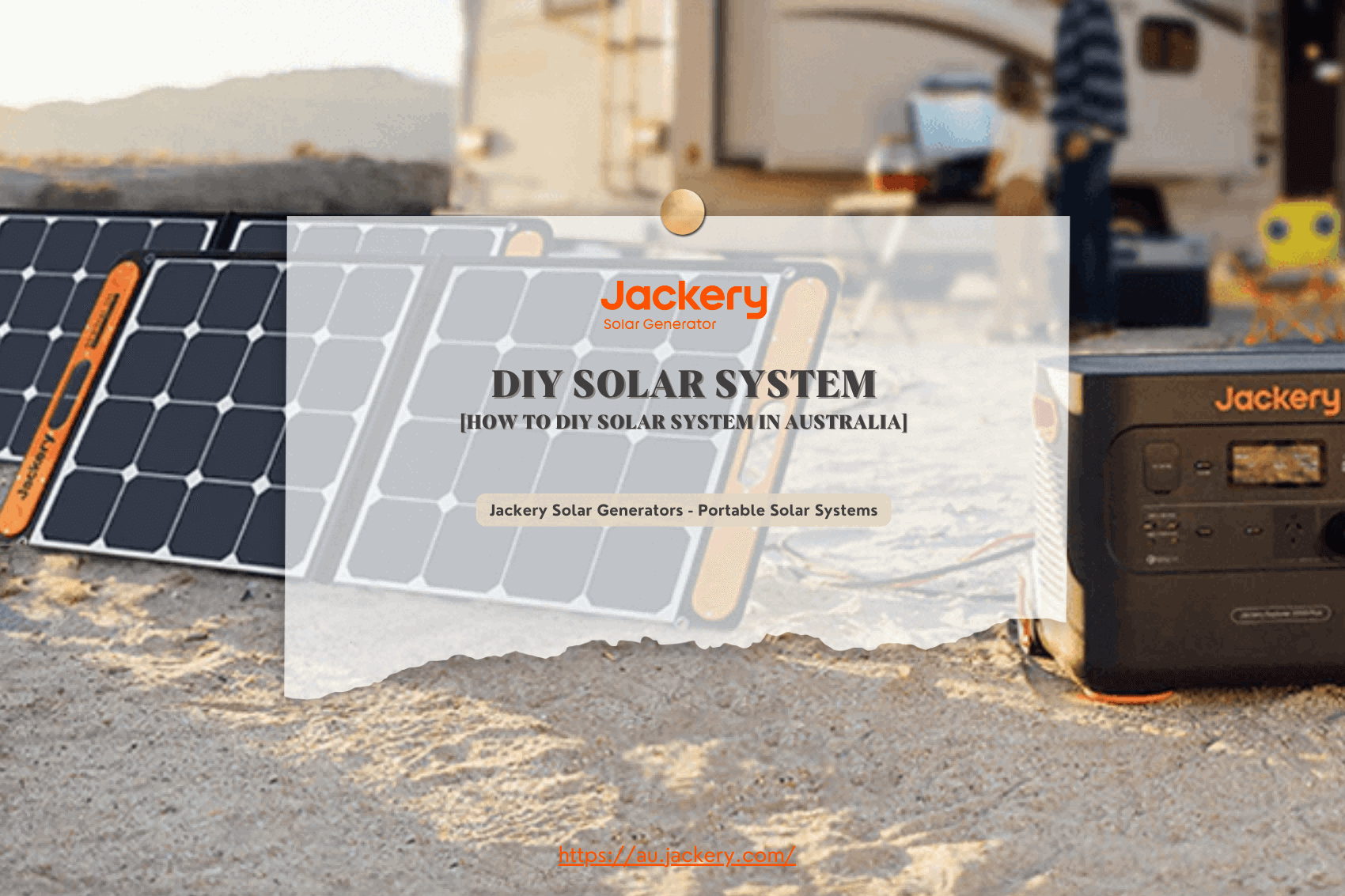|
Key Takeaways: |
|
• Among the different configurations of solar energy systems, the 2kW solar system stands out for its flexibility and efficiency. These systems are suited for household and small-scale commercial applications. • Adopting solar energy systems, particularly 2kW solar systems, provides numerous benefits, including financial savings, environmental stewardship, and energy autonomy. • A 2kW solar system comprises solar panels, a charge controller, an inverter, and solar batteries. A 2kW solar system captures sunlight using photovoltaic (PV) panels. The process begins when sunlight strikes the surface of solar panels. • We highly recommend Jackery Solar Generator 2000 Pro and 2000 Plus as portable 2kW solar system that you can charge appliances in outdoor adventures or home backup. • A 2kW solar power system typically costs between $3,000 and $4,500 with solar incentives. |
What Is A 2kW Solar System?
Solar energy is an abundant and renewable power source from the sun's rays. Photovoltaic cells turn sunlight into electricity, allowing for the generation of sustainable energy. The use of solar energy not only decreases reliance on finite fossil fuels but also eliminates harmful emissions, contributing to environmental conservation.
Solar energy has emerged as a critical answer in the search for sustainable energy sources, offering an environmentally friendly alternative to traditional types of power generation. The 2kW solar system is a fundamental component in solar energy systems. This page will examine the significance of 2kW solar systems, explain their components, and discuss their role in the renewable energy landscape.
Among the different configurations of solar energy systems, the 2kW solar system stands out for its flexibility and efficiency. These systems are suited for household and small-scale commercial applications, offering users a sustainable energy solution tailored to their needs. Solar power users can promote energy independence and environmental stewardship by cutting their electricity expenses and significantly reducing their carbon footprint.
In solar energy systems, kilowatts (KW) are the unit of power capacity. A 2kW solar system can generate 2 kilowatts of power under ideal conditions. This number depicts the system's output capacity, which indicates how much energy it can generate at any particular time. The KW rating is an essential factor in determining the compatibility and performance of solar installations, assisting consumers in selecting the optimal system size for their energy needs.
What Are The Advantages of A 2kW Solar System?
Adopting solar energy systems, particularly 2kW solar systems, provides numerous benefits, including financial savings, environmental stewardship, and energy autonomy. In this post, we look at the benefits of 2kW solar systems, emphasising their importance in promoting sustainable living and tackling energy concerns.
- Cost Savings: Installing a 2kW solar system can save significant long-term costs. Customers can reduce their reliance on grid power by using the sun's energy to generate electricity, cutting their monthly utility bills. The initial investment in solar PVs and associated components can be offset by various financial incentives, including government rebates, tax credits, and net metering programmes, increasing the economic viability of solar energy use. Solar power has a lengthy lifespan of 25-30 years and can provide significant returns on investment for individuals and businesses.
- Environmental Impact: Besides financial benefits, 2kW solar systems reduce greenhouse gas emissions and mitigate the negative consequences of climate change. In contrast to conventional power generation methods that utilise fossil fuels, solar energy is both renewable and environmentally friendly, as it does not emit any hazardous byproducts.
- Conserve Energy: Using solar power instead of carbon-intensive electricity sources helps preserve air quality and reduce global warming. Furthermore, using solar energy helps to conserve natural resources and minimise ecological degradation caused by resource extraction and energy generation, boosting environmental sustainability and conservation efforts.
- Energy Independence: Another significant advantage of 2kW solar systems is their potential for energy independence and portable power options. Solar energy is a feasible alternative for supplying electricity in rural or off-grid locations where regular utility infrastructure may be inadequate or unreliable. Users can employ a 2kW solar system with battery storage to generate electricity for their homes, companies, or recreational vehicles, enabling self-sufficiency and resilience in power outages or emergencies.
What Are The Components of A 2kW Solar System?
A 2kW solar system provides benefits beyond financial savings, including environmental stewardship, energy independence, and portable power solutions. By utilising the sun's abundant energy, consumers can reduce their carbon footprint, lower their electricity bills, and have more control over their energy source. The system's components are as follows:
- Solar panels
- Charge controller
- Inverter
- Solar batteries
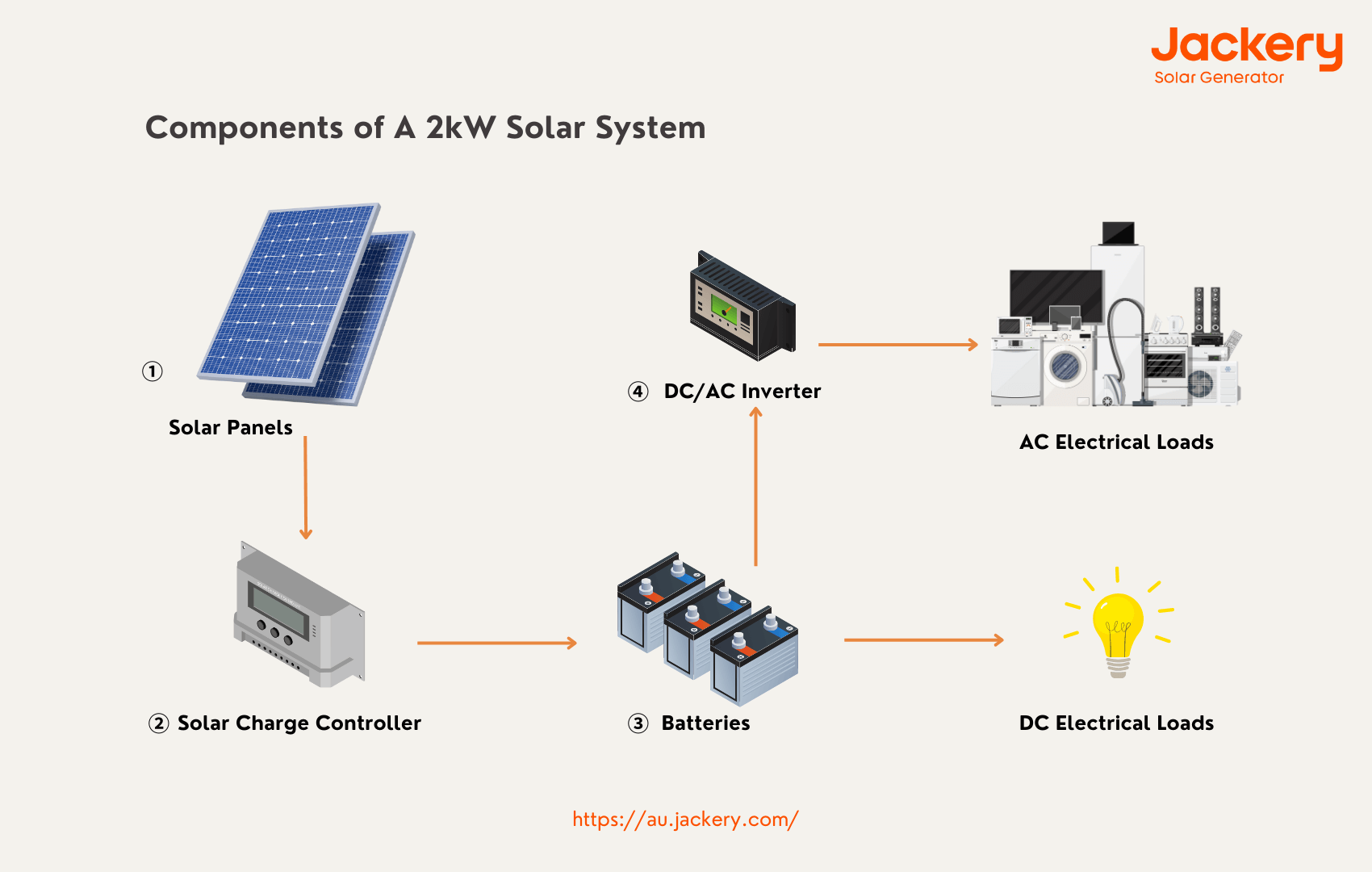
Solar PVs capture sunlight and convert it into electricity at the heart of a 2KW solar system. These panels comprise an interconnected array of solar cells, commonly silicon-based semiconductors. The efficiency and dimension of the solar panels determine the system's overall output capacity as technological breakthroughs continue to improve energy conversion rates.
A charge controller is a critical component that regulates power flow between solar panels and batteries, preventing overcharging and damage. Charge controllers protect batteries from overcharging and increase charging efficiency, increasing their lifespan. Look for a charge controller that matches the voltage and capacity of your solar system. Consider maximum charging current, voltage regulation, and temperature correction.
Inverters are needed to transform the DC electricity solar panels generate into AC electricity appropriate for domestic use. They play an essential part in solar energy systems. In a 2KW configuration, a correctly sized inverter ensures maximum energy conversion efficiency, allowing for easy integration with the current electrical grid or freestanding off-grid applications.
Batteries, while optional, are an essential component of 2KW solar systems since they allow energy to be stored for later use or during periods of low sunshine availability. Battery storage systems enable consumers to maximise self-consumption of solar energy, increasing energy autonomy and resilience. Depending on the user's unique needs and preferences, multiple battery technologies, such as lead-acid or lithium-ion, can be integrated into the system architecture.
How Does A 2kW Solar System Work?
A 2kW solar system captures sunlight using photovoltaic (PV) panels. The process begins when sunlight strikes the surface of solar panels made of semiconductor materials like silicon. Photons from sunlight excite electrons in semiconductor materials, resulting in direct current (DC).
This direct current (DC) electricity is then sent through wiring to an inverter, where it is converted into alternating current (AC) electricity appropriate for usage in homes and businesses. The AC electricity generated by the inverter can subsequently be used to power appliances and devices on the premises.
Excess power generated by the system can be stored in batteries for future use or exported to the grid via net metering programs, depending on the user's settings and preferences. Overall, the operation of a 2kW solar system includes converting sunlight into usable electrical energy, resulting in a renewable and sustainable power source for various uses.
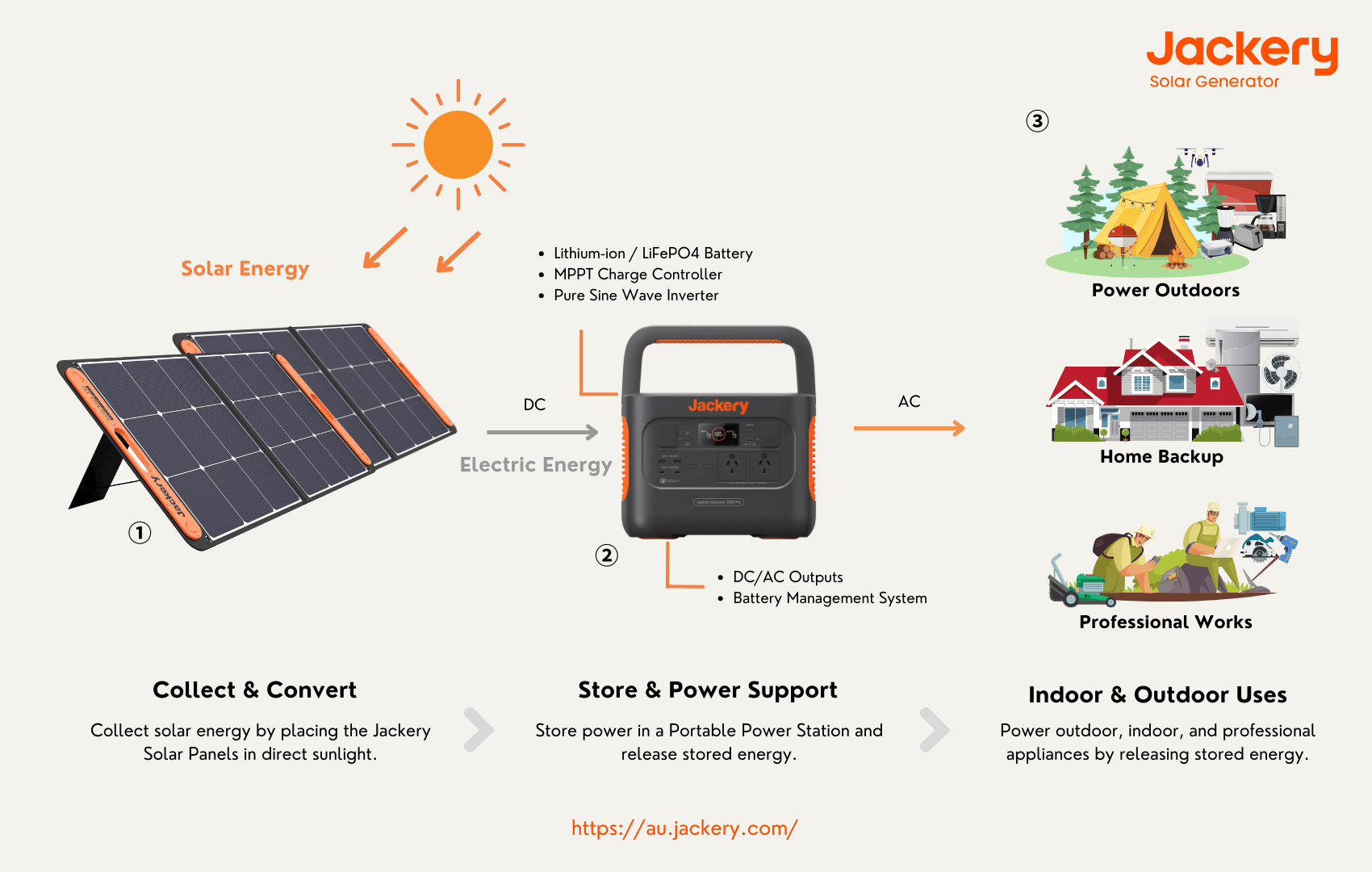
The Jackery Solar Generator is a portable 2kW solar power generator intended to supply electricity for outdoor activities, emergencies, and distant locations. It has two primary components: Jackery Solar Panels and Portable Power Stations. Jackery Solar Panels, often foldable or portable, absorb sunlight and convert it to power using photovoltaic technology. The electricity generated is kept in a Portable Power Station, an energy reservoir.
The battery pack relies on lithium-ion cells to store electrical energy effectively and dependably. The Jackery Solar Generator's inverter turns stored DC electricity into alternating current, allowing electronic devices and appliances to operate. The Jackery Solar Generator's compact and lightweight design makes it easy to travel and deploy in various outdoor situations, giving consumers a practical and dependable power source for camping, hiking, RV excursions, and disaster preparedness.
Jackery Solar Generators: Portable 2kW Solar Systems
Both the 2kW solar system and the Jackery Solar Generator demonstrate the flexibility and adaptability of solar energy systems. The 2kW solar system is intended for stationary installations on rooftops or ground-mounted structures, offering grid-connected or off-grid electricity for residential and commercial applications.
The Jackery Solar Generator provides portable power solutions for mobile use. Despite differences in scale and application, both systems use solar energy to generate clean, renewable electricity, contributing to energy independence, sustainability, and resilience.

Jackery Solar Generator 2000 Plus
Jackery's high-performance Solar Generator 2000 Plus substantially advances portable power options. Its massive capacity and high power output allow it to power standard vans for weeks, making it ideal for outdoor trips or home backup power supply. Incorporating battery cells into the Jackery Solar Generator 2000 Plus increases capacity from 2 kWh to 12 kWh, resulting in a paradigm shift in household backup power supply.
The Explorer 2000 Plus can deliver up to 3000W and has a 30% higher rated power than comparable 2 kWh models. Powered devices make up the vast majority of essential household appliances. Despite its regular use, the Solar Generator 2000 Plus can be fully charged in 6 hours (using 6* SolarSaga 100W solar panels). The power source becomes self-sufficient, charging from solar energy instead of the power grid.
The add-on battery pack can be charged with solar panels, providing additional flexibility while boosting charging efficiency and saving time. Jackery Solar Panels produce more lifetime energy due to their excellent solar conversion efficiency of up to 25%. Our solar panels produce 50% more electricity in low-light circumstances than traditional solar panels (PERC) and have a more robust spectrum response.
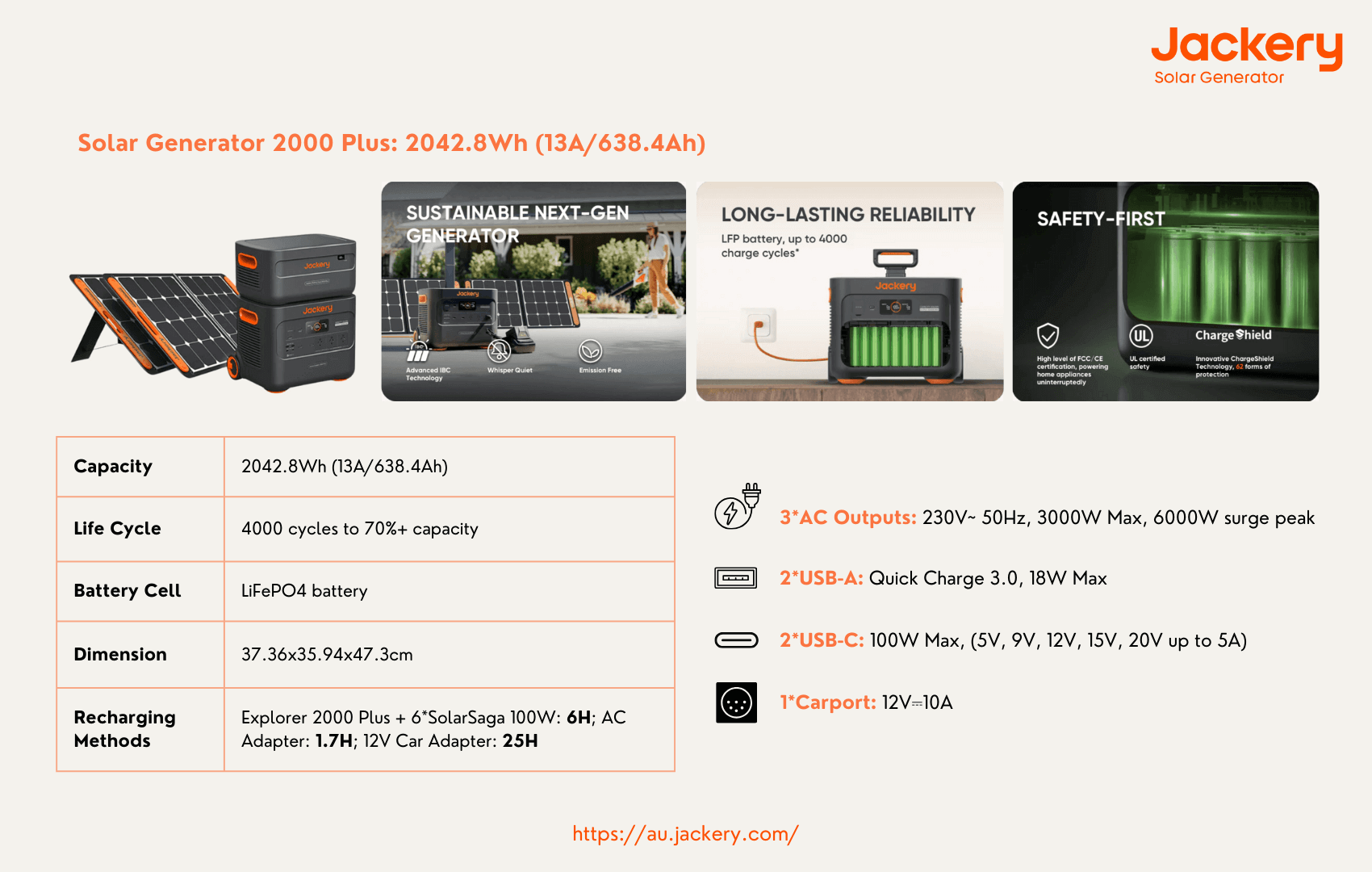
Jackery Solar Generator 2000 Pro
The Jackery Solar Generator 2000 Pro has an exceptional charging capacity of 2,160Wh. It can be charged in under 5.5 hours using 6* SolarSaga 100W solar panels or in only 2 hours using an AC power outlet. Tailored for camping experiences, particularly in locations like New South Wales where electrical outlets are sparse, it becomes an indispensable companion for charging equipment ranging from mini-fridges to phones and illumination.
The Jackery Explorer 2000 Pro portable power station is a dependable emergency backup power supply with a ten-year lifespan and twice-weekly use. Its durability is enhanced by features like heat dissipation and high-temperature protection, ensuring peak performance in various environments. The SolarSaga 100W solar panel's IP67 Waterproof Rating protects it from harsh and moist situations, making it durable and trustworthy.
With a single switch, you may experience the simplicity of endless power. The upgraded input and output display displays give crystal-clear data, including low battery and fault code indicators, providing a smooth and informed operation. The Jackery Solar Generator 2000 Pro combines cutting-edge technology with rugged dependability, providing abundant clean energy to power your travel.
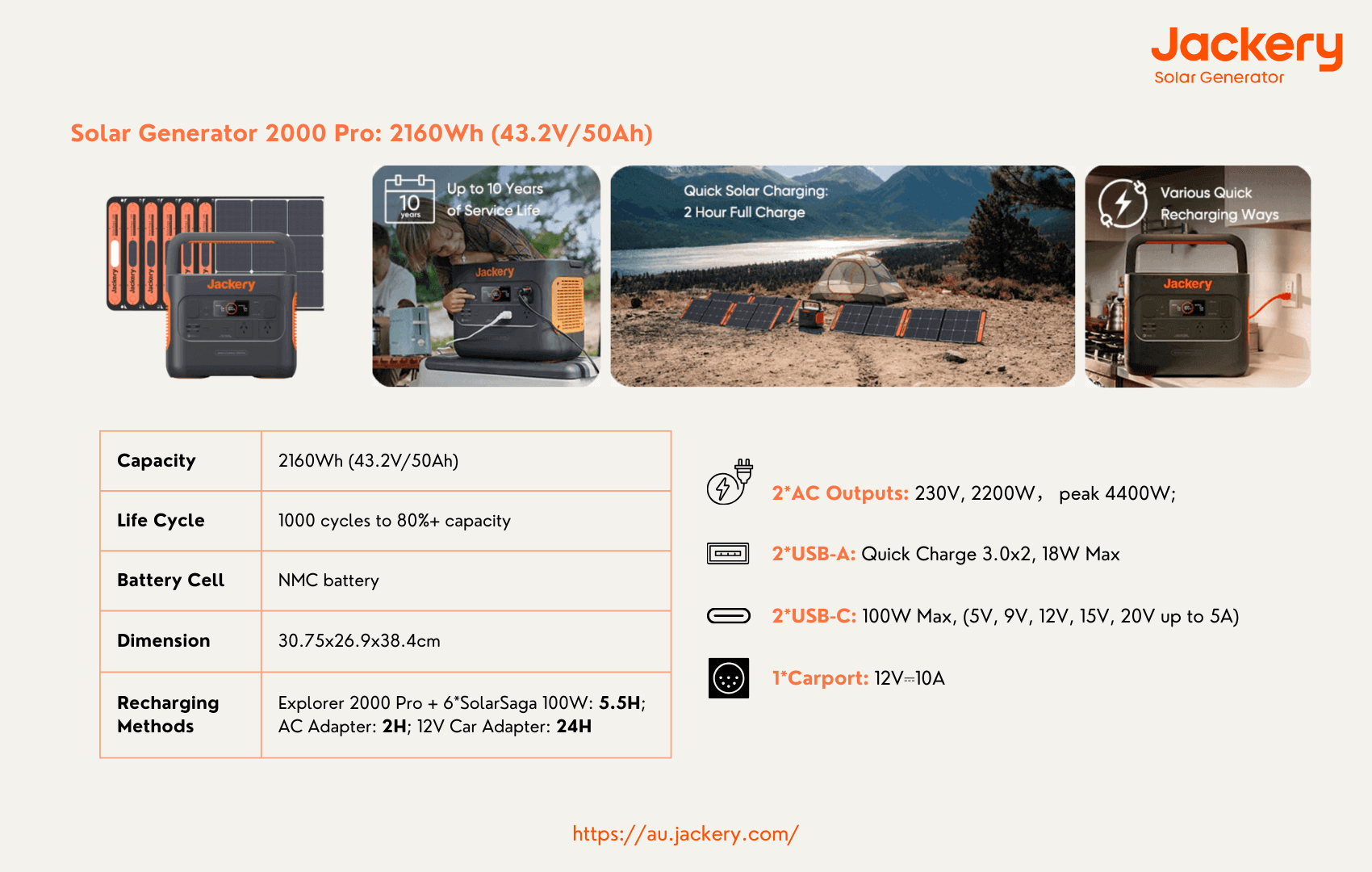
How Much Does A 2kW Solar System Cost?
Typically, a 2kW solar power system costs between $3,000 and $4,500 with solar incentives. However, this cost can vary depending on component quality, installation requirements, and geographic location. A 6.6kW system with more than three times the capacity costs roughly $5,500. This demonstrates the cost-effectiveness of larger solar systems, which offer more energy production potential for a minimal increase in upfront cost.
If conditions are met, a 2kW solar power system can pay for itself in less than four years. Assuming that all of the system's electricity is used in the residence, with an electricity rate of 30 cents per kWh and a 5% annual electricity price increase, the system can pay for itself in this timeframe. However, with the correct system design and incentives, it is possible to have positive cash flow from day one. For example, in Sydney, a 2kW solar system with 300W panels and an inverter typically costs roughly $4,500 for a basic installation. Prices may vary based on panel efficiency and output levels.
How Many Solar Panels Do You Need for A 2kW Solar System?
Usually, the number of solar panels required for a 2kW system is determined by the individual panels' wattage ratings and efficiency. On average, a 2kW solar system comprises 6 to 8 solar panels, each rated at 300 to 350 watts. However, panel size, orientation, and geographic location can all influence the number of panels required to achieve the specified energy output.
Calculate Power Consumption
Before deciding on the quantity of solar panels, it is critical to determine the power consumption of the proposed system. Power consumption is commonly measured in kilowatt-hours (kWh). It indicates the entire quantity of energy consumed by a household or facility over a period, usually monthly or annually.
To calculate power consumption, analyse previous electricity bills to determine typical usage, or use energy monitoring equipment to record consumption in real-time. By analysing past data or forecasting future energy needs based on family size, appliance usage, and lifestyle habits, one can arrive at a fair estimate of power consumption, which can then be used to size the solar system.
|
Appliances A 2KW Solar System Can Run |
|||
|
Appliance |
Watts per hour |
Avg. Hours used daily |
Total Watts |
|
Hot water system |
1200 |
1 |
1200 |
|
Microwave |
1500 |
15 mins |
375 |
|
Dishwasher |
1800 |
1 |
1800 |
|
Washing machine |
500 |
1 |
500 |
|
Wifi |
6 |
24 |
144 |
Decide Solar Panels Needed
After determining the power consumption, the following step is to determine how many solar panels are required to achieve the target energy output of the 2kW solar system. Solar panels are rated according to peak power production, commonly measured in watts (W) or kilowatts (KW). To get the number of panels needed, divide the total desired system capacity (in this case, 2kW) by the wattage rating of each solar panel.
For example, if you use 200W solar panels, split 2,000 watts by 200 watts each panel to get roughly ten panels. Solar panels are usually offered in total units and round up to the following number. In this scenario, seven solar panels are required to create a 2kW solar system. It is crucial to note that additional parameters such as panel efficiency, geographic location, shading, orientation, and tilt angle can all impact the solar system's overall energy output. As a result, it's best to contact a solar energy expert or use online solar calculators to optimise system design and assure adequate energy production.
Consider available roof space, economic limits, and aesthetic preferences when deciding on the ultimate quantity and layout of solar panels for the 2kW system. By carefully examining power consumption and panel specs, one can create an efficient and effective solar energy system that meets their demands and requirements.
2kW Solar System FAQs
The following are the most frequently asked questions about 2kW solar systems in Australia:
1. How do you choose the best 2kW solar system?
When selecting the ideal 2kW solar system for your needs, numerous criteria must be considered to ensure peak performance, dependability, and cost-effectiveness. These factors include:
|
Factors |
Considerations |
|
Component Quality |
Choosing high-quality components is critical to the overall performance and lifetime of the solar system. This comprises the solar panels, inverters, mounting hardware, and wiring. Look for recognised manufacturers with a track record of dependability and durability. |
|
Warranty |
Evaluate the warranty coverage provided by solar system components such as panels, inverters, and batteries. A comprehensive warranty ensures against defects, malfunctions, and performance deterioration, giving peace of mind and protecting your investment. |
|
System Monitor |
Consider purchasing a solar system with built-in monitoring and control features, which allow you to measure energy generation, monitor system performance, and troubleshoot problems remotely. |
|
Financial Considerations |
Determine the total cost of the solar system, including initial installation costs, ongoing maintenance expenditures, and any financing alternatives. Compare quotations from various solar providers to ensure fair pricing and terms. |
When selecting a 2kW solar system, carefully evaluate these variables to choose the ideal solution that suits your needs, tastes, and budget while maximising energy production, efficiency, and savings during the system's lifetime.
2. How much power does a 2kW solar system generate?
A 2kW solar system may generate around 2,000 watts of electricity under ideal conditions. However, the energy output varies according to solar intensity, panel efficiency, shade, and system orientation. On average, a well-designed and well-built 2kW solar system may provide between 2,800 and 3,600 kilowatt-hours (kWh) of electricity per year, depending on geographic location and weather patterns.
3. What can a 2kW solar system run?
A 2kW solar system may power various household appliances and equipment, such as lights, electronics, refrigerators, air conditioners, and heating systems. However, the system's ability to meet your unique energy needs is determined by energy use habits, system efficiency, and available sunshine. The solar system must be appropriately sized depending on your energy requirements and usage habits to ensure enough power supply and maximise the benefits of solar energy.
4. Is a 2kW solar system worth it?
Several factors, including your energy use, available roof space, budget, and energy goals, determine the value of a 2kW solar system. A 2kW solar system can drastically cut power bills and provide a dependable renewable energy source for smaller houses with low energy requirements. Furthermore, government incentives, tax credits, and net metering programmes can increase the financial benefits of solar energy adoption. It is best to speak with a solar professional to examine your requirements and determine the feasibility and cost-effectiveness of a 2kW solar system on your property.
Final Thoughts
In conclusion, our definitive guide to the 2kW solar system demonstrates that embracing solar energy is more than simply a decision; it is a transforming path towards sustainability. You can make informed decisions for a more sustainable future by understanding the components, operating principles, and efficient utilisation of a 2kW solar system. As you explore incorporating this solar solution into your lifestyle, remember that Jackery is here to help you illuminate your route to a brighter, more environmentally responsible future.























































